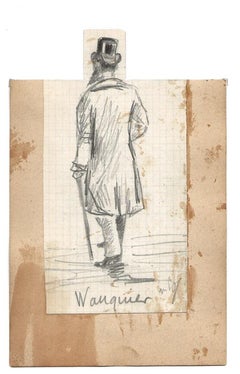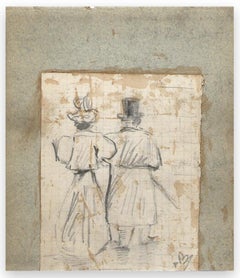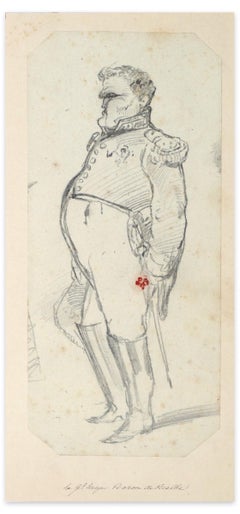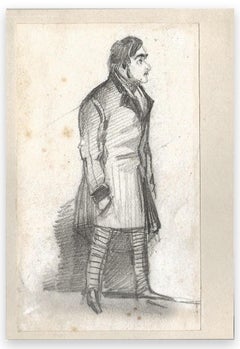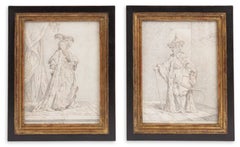Etienne Omer Wauquier Art
to
4
Overall Width
to
Overall Height
to
4
4
4
4
3
2
2
2
1
1
1
4
4
4
10,083
2,775
1,380
1,375
4
Artist: Etienne Omer Wauquier
Man with a Hat - Original Pencil Drawing by E. O. Wauquier - Mid-19th Century
By Etienne Omer Wauquier
Located in Roma, IT
Man with a hat on the back is an original drawing in gray point pencil on paper, realized by Etienne Omer Wauquier (1808-1869).
Good conditions except for minor cosmetic wear.
Han...
Category
Mid-19th Century Modern Etienne Omer Wauquier Art
Materials
Paper, Pencil
Couple in Hat Walking from Behind - Pencil by Wauquier - Mid-19th Century
By Etienne Omer Wauquier
Located in Roma, IT
Couple in hat walking from behind is an original drawing in pencil with gray tip on paper, realized by E. O. Wauquier.
Good conditions except for minor cosmetic wear.
Hand-signed WAUQUIER. French school of the XIXth century. Grid paper...
Category
Mid-19th Century Modern Etienne Omer Wauquier Art
Materials
Paper, Pencil
The General….Baron de Brielhe - Pencil by E. O. Wauquier - Mid-19th Century
By Etienne Omer Wauquier
Located in Roma, IT
The general ... Baron De Brielhe is an original drawing in pencil with gray point, unsigned, on paper, realized by E. O. Wauquier (1808-1869).
Good conditions except for minor cosme...
Category
Mid-19th Century Modern Etienne Omer Wauquier Art
Materials
Paper, Pencil
Man Pants with Side Line - Original Pencil by E. O. Wauquier - Mid-19th Century
By Etienne Omer Wauquier
Located in Roma, IT
Man pants with side line is an original drawing in pencil point grisen on paper, realized by E.O. Wauquier (1808-1869).
Good conditions except for minor cos...
Category
Mid-19th Century Modern Etienne Omer Wauquier Art
Materials
Paper, Pencil
Related Items
"Contemplation"
By Gershon Benjamin
Located in Lambertville, NJ
Jim’s of Lambertville is proud to offer this artwork by:
Gershon Benjamin (1899-1985)
An American Modernist of portraits, landscapes, still lives, and the urban scene, Gershon Benj...
Category
1920s Modern Etienne Omer Wauquier Art
Materials
Graphite
Costume drawings for ‘Ambassadeur de Siam’ and ‘La Sultana Reine’
Located in Amsterdam, NL
Joseph-Marie Vien (1716-1809)
‘Ambassadeur de Siam’ and ‘La Sultana Reine’
Both titled lower centre, the drawing of the ambassador inscribed with colours intended for the prints, e...
Category
Mid-18th Century Old Masters Etienne Omer Wauquier Art
Materials
Paper, Pencil
$8,248
H 9.26 in W 6.89 in D 1.19 in
Male Torso
By John Koch
Located in London, GB
Pencil, coloured pencil and chalk on paper, titled (lower left), signed (lower right), 31cm x 46cm, (51cm x 68cm framed).
John Koch was an American painter and teacher, and an impo...
Category
1950s American Modern Etienne Omer Wauquier Art
Materials
Paper, Chalk, Pencil, Color Pencil
Modern Early Black and White Charcoal Artist Self Portrait Drawing
Located in Houston, TX
Modern early black and white artist self portrait by Houston artist Edsel Cramer. The work features a young portrait of the artist staring directly forward and cropped within an off-...
Category
1940s American Modern Etienne Omer Wauquier Art
Materials
Paper, Charcoal, Graphite
$1,500
H 18.75 in W 16.75 in D 0.5 in
Young man in a toga elegant man Latin American hyperrealist Hockney style
By Claudio Bravo
Located in Norwich, GB
Superb original drawing in coloured conté pencils, heightened with white on oatmeal coloured vergé paper by Claudio Bravo. The work was created during the artist's Moroccan period, a...
Category
1970s Modern Etienne Omer Wauquier Art
Materials
Conté, Laid Paper, Color Pencil
$7,500
H 30.32 in W 24.02 in D 0.4 in
A Handsome 1940s Portrait of a Seated Man by Chicago Artist, Harold Haydon
By Harold Haydon
Located in Chicago, IL
A Handsome 1940s Portrait of a Seated Man by Chicago Modern Artist, Harold Haydon (Am. 1909-1994). A wonderfully executed line drawing dating from 1946 with great character; looks ...
Category
Mid-20th Century American Modern Etienne Omer Wauquier Art
Materials
Paper, Graphite
$135
H 20 in W 16 in D 0.13 in
Chef Basting Chicken with Madeline Watching
By Ludwig Bemelmans, 1898-1962
Located in Miami, FL
This large Bemelans features a small image of Madeline in the smoke behind the chef's face. It was most likely preliminary work for an illustration with Madeline and the Chef that a...
Category
1950s American Modern Etienne Omer Wauquier Art
Materials
Paper, Watercolor, Gouache, Pencil
$25,000
H 27 in W 21.25 in
Untitled, Nude drawing on paper
Located in Miami Beach, FL
Untitled, 1984 by Enrique Grau
Graphite on paper
Signed in the lower right corner. Great condition.
Provenance: Private collection.
Image size: 12 in H x ...
Category
1980s Modern Etienne Omer Wauquier Art
Materials
Archival Paper, Graphite
Mon Colonel
By Auguste Chabaud
Located in London, GB
'Mon Colonel', pencil and crayon on paper, by noted French artist, Auguste Chabaud (circa 1914-1918). A delightfully simple drawing of a French Army colonel in profile along with clo...
Category
1910s Modern Etienne Omer Wauquier Art
Materials
Paper, Crayon, Pencil
A Sensitive 1950s Mid-Century Modern Portrait of a Young Man By Harold Haydon
By Harold Haydon
Located in Chicago, IL
A Sensitive, Finely Rendered 1950s Mid-Century Modern Portrait of a Young Man By Noted Chicago Artist, Harold Haydon (Am. 1909-1994). Artwork size: 12 x 9 1/2 inches. Artwork is un...
Category
Mid-20th Century American Modern Etienne Omer Wauquier Art
Materials
Paper, Graphite
$385
H 16 in W 12 in D 0.13 in
Respite
Located in London, GB
Pencil on paper
Signed and dated (lower right)
29cm × 21cm (48cm × 39cm framed)
A truly original artist, Lear spent most of his 70 year career exploring beautifully proportioned mal...
Category
1980s American Modern Etienne Omer Wauquier Art
Materials
Paper, Pencil
Circus girl reclining
By Walt Kuhn
Located in Miami, FL
Signed and dated center right, Seam down center where two sheets attached is original. Some slight surface smudging outside figure area .
Category
1920s Modern Etienne Omer Wauquier Art
Materials
Carbon Pencil, Magazine Paper
Etienne Omer Wauquier art for sale on 1stDibs.
Find a wide variety of authentic Etienne Omer Wauquier art available for sale on 1stDibs. You can also browse by medium to find art by Etienne Omer Wauquier in paper, pencil and more. Much of the original work by this artist or collective was created during the 19th century and is mostly associated with the modern style. Not every interior allows for large Etienne Omer Wauquier art, so small editions measuring 3 inches across are available. Etienne Omer Wauquier art prices can differ depending upon medium, time period and other attributes. On 1stDibs, the price for these items starts at $99 and tops out at $267, while the average work can sell for $104.
